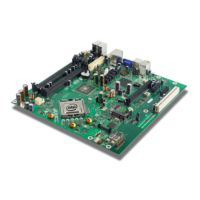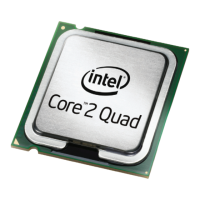ATX Thermal/Mechanical Design Information
54 Thermal and Mechanical Design Guidelines
6.2.2 Acoustics
To optimize acoustic emission by the fan heatsink assembly, the reference design
implements a variable speed fan. A variable speed fan allows higher thermal
performance at higher fan inlet temperatures (T
A
) and lower thermal performance with
improved acoustics at lower fan inlet temperatures. The required fan speed necessary
to meet thermal specifications can be controlled by the fan inlet temperature and
should comply with requirements in Table 6–2.
Table 6–2. Acoustic Results for ATX Reference Heatsink (E18764-001)
Fan
Speed
RPM
Thermist
or Set
Point
Acoustic Thermal Requirements,
ca Notes
3900
High
T
A
= 40 °C
5.0 BA
• 0.50° C/W (Core™2 Duo processor E8000 series 6
MB)
• 0.52° C/W (Core™2 Duo processor E7000 series 3
MB, Pentium dual-core processor E6000, E5000
series 2 MB, and Intel
®
Celeron
®
processor E3000
series with 1 MB)
2000
Low
T
A
= 30 °C
3.5 BA
• 0.65° C/W (Core™2 Duo processor E8000 series
with 6 MB)
• 0.68 °C/W (Core™2 Duo processor E7000 series 3
MB, Pentium dual-core processor E6000, E5000
series 2 MB, and Intel
®
Celeron
®
processor E3000
series with 1 MB)
Thermal Design
Power, Fan
speed limited
by the fan hub
thermistor
NOTES:
1. Acoustic performance is defined in terms of measured sound power (LwA) as defined in
ISO 9296 standard, and measured according to ISO 7779.
While the fan hub thermistor helps optimize acoustics at high processor workloads by
adapting the maximum fan speed to support the processor thermal profile, additional
acoustic improvements can be achieved at lower processor workload by using the
T
CONTROL
specifications described in Section 2.2.4. Intel recommendation is to use the
fan with 4 Wire PWM Controlled to implement fan speed control capability based
digital thermal sensor temperature. Refer to Chapter 7 for further details.
Note: Appendix F gives detailed fan performance for the Intel reference thermal solutions
with 4 Wire PWM Controlled fan.
6.2.3 Altitude
Many companies design products that must function reliably at high altitude, typically
1,500 m [5,000 ft] or more. Air-cooled temperature calculations and measurements at
the test site elevation must be adjusted to take into account altitude effects like
variation in air density and overall heat capacity. This often leads to some degradation
in thermal solution performance compared to what is obtained at sea level, with lower
fan performance and higher surface temperatures. The system designer needs to
account for altitude effects in the overall system thermal design to make sure that the
T
C
requirement for the processor is met at the targeted altitude.

